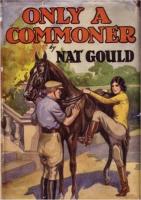
Nat Gould
His life and books
Only a Commoner
First published in 1895, this was the ninth of Nat Gould's novels to be published in book form, and the last to be written in Sydney before Nat Gould's return to England in that year. The publisher was George Routledge and Sons Ltd of London.
A copy of the first edition inscribed "To my dear wife from her loving husband Nat Gould Sept. 20 '95" was presented to the Walker Collection in the Hobart Public Library by Professor E. Miller Morris, Chairman of the Trustees, presumably because of the setting of the story in Tasmania (1).
When first published the New York Times gave it the following review (2): "This is a 'No Nonsense' story. There is the yeoman father and his good son Tom Wilde. The family has lived on a farm as tenants of the Duke for three generations. Then there is the utterly bad agent, Hugh Ralton, who has a grudge against the Wildes ... Much of the book has to do with the bad behaviour of Ralton, and there is a great deal about horses and horse racing in a rather commonplace story."
Nevertheless the novel proved popular with its readers, and was reissued in 1919 by John Long Ltd, and later in 1935, 1938 and 1960.
John Wilde and his son Tom leave their Derbyshire farm because of their ill-treatment by the ducal agent Hugh Ralton. They buy a farm near Hobart in Tasmania, and Tom acquires a mystery mare and foal in partnership with Jos Kelly. He suspects that the mare had been stolen from George Andrews. Ralton is sacked by the duke, and he too emigrates to Australia. At the home of William and Violet Rath near Hobart, Ralton meets Tom and they quarrel. Ralton schemes to ruin the Wildes by revealing the true ownership of the foal at the prestigious Hobart Cup race, but is foiled by Tom and his friends.
A gripping tale, vividly told with an exciting climax. The early Derbyshire scenes are beautifully portrayed, as is the rural hinterland of Hobart, and the characters of the Wildes and their friends are excellently drawn. A very good read indeed. (TA)
(1) The Mercury (Hobart) newspaper dated 19 February 1940.
(2) New York Times 25 August 1895

